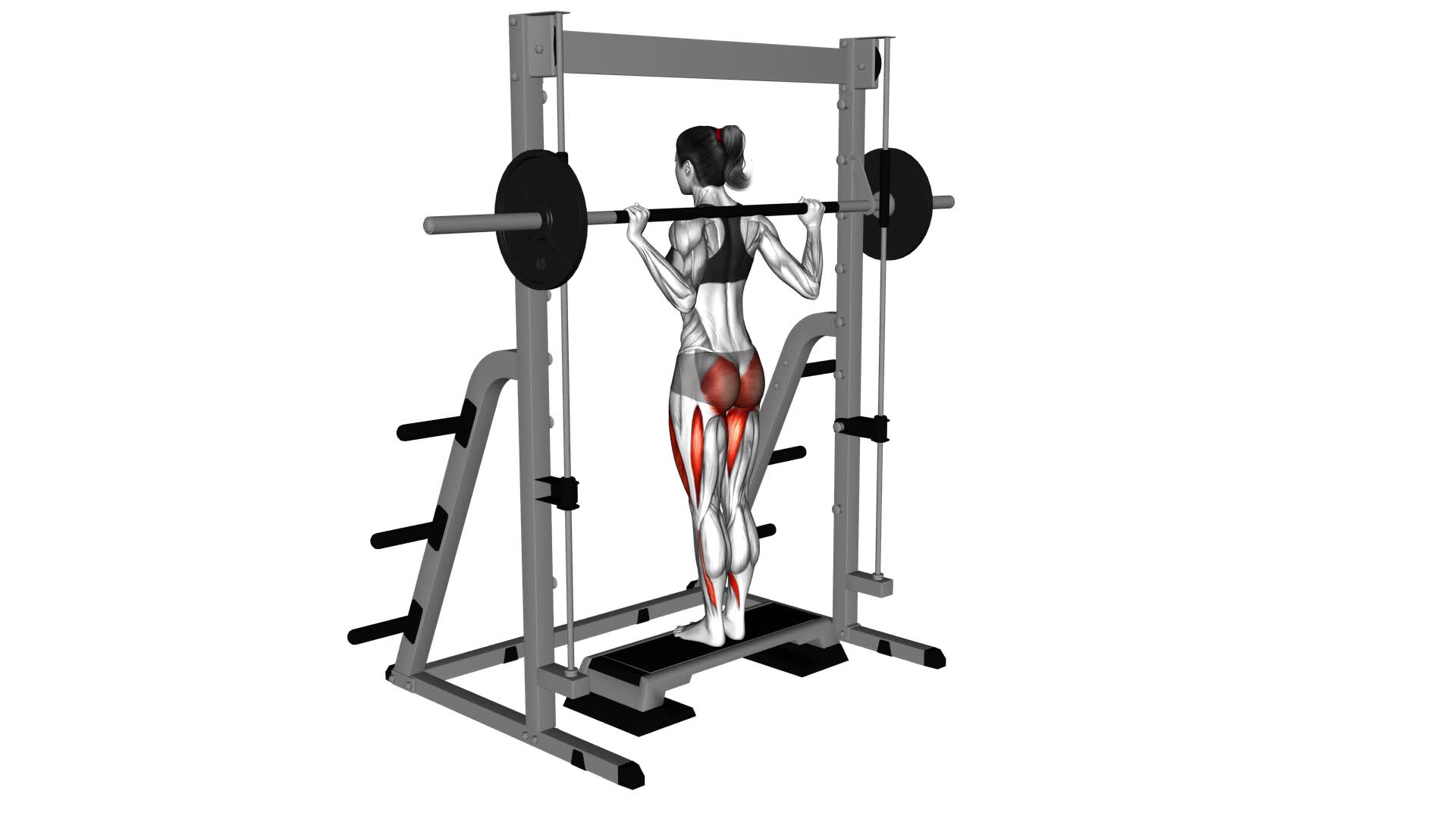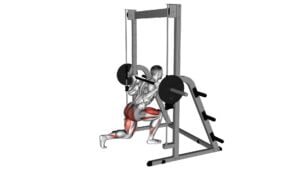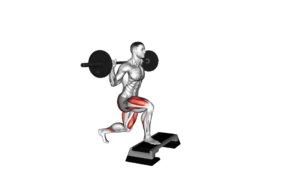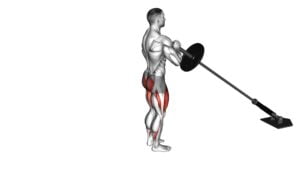Smith Rear Lunge (Version 2) (Female) – Video Exercise Guide & Tips

Looking to tone your legs and glutes? Check out the Smith Rear Lunge (Version 2) exercise! This video exercise guide and tips will show you the proper form and technique to maximize your results.
Watch This Exercise Video
Learn about the benefits, common mistakes to avoid, and variations to keep your workouts fresh. Whether you're a beginner or experienced, this guide has got you covered.
Get ready to sculpt your lower body and achieve your fitness goals!
Key Takeaways
- Engaging multiple muscle groups simultaneously (quadriceps, hamstrings, glutes, calves)
- Saving time by targeting several major muscle groups in one exercise
- Improving balance and stability
- Suitable for beginners or individuals with limited balance
Benefits of the Smith Rear Lunge (Version 2)
Experience the numerous benefits of the Smith Rear Lunge (Version 2) by incorporating this dynamic exercise into your fitness routine.
The Smith Rear Lunge (Version 2) offers several advantages that make it an effective exercise for targeting your lower body muscles. One of the key benefits is its ability to engage multiple muscle groups simultaneously, including your quadriceps, hamstrings, glutes, and calves. This means that you can efficiently work out several major muscle groups in one exercise, saving you time and maximizing your workout sessions.
Another advantage of the Smith Rear Lunge (Version 2) is its effectiveness in improving balance and stability. By performing lunges on the Smith machine, you have the added support of the barbell, allowing you to focus on maintaining proper form and technique without worrying about balance issues. This makes it a great exercise option for beginners or individuals with limited balance.
In addition to its muscle-building and balance-enhancing benefits, the Smith Rear Lunge (Version 2) also helps to improve overall lower body strength and power. As you lunge backward, you're required to push through your front leg to return to the starting position, which helps to develop explosive strength in your legs.
Now that you understand the advantages and effectiveness of the Smith Rear Lunge (Version 2), let's move on to the next section, where we'll discuss the proper form and technique for performing this exercise.
Proper Form and Technique
To perform the Smith Rear Lunge (Version 2) with proper form and technique, position yourself facing the Smith machine barbell with your feet shoulder-width apart. Here are some key points to keep in mind to ensure you execute this exercise correctly:
- Keep your back straight and engage your core throughout the movement. This will help maintain stability and prevent any strain on your lower back.
- Take a step backward with one foot, keeping your weight evenly distributed between both legs. Lower your body by bending your front knee and hip, until your back knee is just above the ground.
- As you lunge, make sure your front knee stays in line with your toes and doesn't extend past them. This will help protect your knee joint and promote proper alignment.
Proper execution of the Smith Rear Lunge (Version 2) is crucial to maximize its benefits and minimize the risk of injury. By following these guidelines, you can ensure that you're performing the exercise correctly and effectively.
However, there are some common errors to watch out for:
- Avoid leaning too far forward or backward. This can put unnecessary strain on your back and compromise your form.
- Don't let your front knee collapse inward. Keep it aligned with your toes to maintain proper tracking and stability.
- Avoid rushing through the movement. Take your time to lower and raise your body, focusing on control and stability.
Common Mistakes to Avoid
To avoid common mistakes during the Smith Rear Lunge (Version 2) exercise, focus on maintaining proper form and technique. One common mistake is allowing your knee to extend beyond your toes during the lunge. This puts excessive strain on the knee joint and increases the risk of injury. To prevent this, make sure to step far enough back from the bar so that your front knee stays directly above your ankle when you lower into the lunge position.
Another mistake to avoid is leaning too far forward or backward during the movement. This can lead to loss of balance and improper activation of the muscles. Instead, keep your upper body upright and engage your core to maintain stability throughout the exercise.
Additionally, it's important to avoid rushing through the exercise. Take your time to perform each rep with control and focus on the muscles you're targeting. By paying attention to these common mistakes and maintaining proper form, you'll maximize the effectiveness of the Smith Rear Lunge (Version 2) exercise and reduce the risk of injury.
Now, let's explore some variations and modifications you can incorporate to add variety to your workout routine.
Variations and Modifications
For added variety to your workout routine, try incorporating different variations and modifications of the Smith Rear Lunge (Version 2) exercise. By making these adjustments, you can challenge your muscles in new ways and continue to progress in your fitness journey.
Here are three options to consider:
- Weighted Rear Lunge: Hold a pair of dumbbells or a barbell on your shoulders while performing the rear lunge. This added resistance will increase the intensity of the exercise and help build strength in your lower body.
- Plyometric Rear Lunge: Incorporate a jump into the rear lunge to add a cardiovascular element and explosiveness to the exercise. Start in a lunge position and explosively jump into the air, switching legs mid-air and landing back into a lunge position.
- Deficit Rear Lunge: Elevate your front foot by stepping onto a step or platform, creating a larger range of motion for the exercise. This variation targets your glutes and hamstrings even more and can help improve overall lower body strength.
When it comes to equipment modifications, you can use a Smith machine, barbell, dumbbells, or even just your body weight. The key is to choose the option that suits your fitness level and goals. Remember to always maintain proper form and listen to your body to prevent any injuries.
Keep challenging yourself with these variations and modifications to continually progress and see results in your fitness journey.
Tips for Maximizing Results
To maximize your results, focus on maintaining proper form and pushing yourself to the limit during each Smith Rear Lunge (Version 2) exercise. This will ensure that you're engaging the correct muscles and getting the most out of your workout.
It's important to stay motivated throughout your fitness journey, so here are a few tips to help you along the way.
First, set realistic goals and track your progress. This will give you a sense of accomplishment and keep you motivated to continue.
Additionally, find a workout buddy or join a fitness class to keep yourself accountable and make exercising more enjoyable.
Lastly, make sure to fuel your body with the right nutrition. Eating a balanced diet that includes lean proteins, fruits, vegetables, and whole grains will provide you with the energy you need to perform at your best.
Remember, consistency is key, so stay disciplined and motivated to see the results you desire.
Now that you have some tips for maximizing your results, let's move on to the next section about safety precautions and considerations.
Safety Precautions and Considerations
Prioritize your safety by following these important considerations when performing the Smith Rear Lunge (Version 2) exercise.
- Warm-up: Before starting any exercise, it's crucial to warm up your muscles to prevent injury. Spend a few minutes doing dynamic stretches or light cardio to increase blood flow and prepare your body for the workout.
- Maintain proper form: When performing the Smith Rear Lunge (Version 2), it's important to maintain proper form to avoid strain or injury. Keep your back straight, chest up, and core engaged throughout the movement. Make sure your knee doesn't extend past your toes when lowering into the lunge position.
- Use appropriate equipment: To ensure safety and effectiveness, it's recommended to use a Smith machine for this exercise. The Smith machine provides stability and support, reducing the risk of falls or injuries. Additionally, using a weightlifting belt can provide extra support and protect your lower back during heavy lifts.
By following these safety precautions, you can minimize the risk of injury and maximize the benefits of the Smith Rear Lunge (Version 2) exercise. Remember to start with lighter weights and gradually increase the intensity as you become more comfortable and confident with the movement.
Always listen to your body and consult with a fitness professional if you have any concerns or questions. Stay safe and enjoy your workout!
Frequently Asked Questions
How Many Calories Can You Burn by Performing the Smith Rear Lunge (Version 2)?
Performing the Smith Rear Lunge (Version 2) can help you burn calories and activate your muscles. The exact number of calories burned depends on various factors such as your weight, intensity, and duration of the exercise.
However, lunges in general are considered a compound exercise that engages multiple muscle groups, including the glutes, quads, and hamstrings.
Can the Smith Rear Lunge (Version 2) Help Improve Balance and Stability?
The Smith Rear Lunge (Version 2) can definitely help improve your balance and stability. By incorporating this exercise into your routine, you can reap the benefits of enhanced balance and stability.
The Smith Rear Lunge (Version 2) specifically targets the muscles that support these areas, making it an effective choice for improving your overall stability.
Is It Safe to Perform the Smith Rear Lunge (Version 2) With a Knee Injury?
Performing the Smith Rear Lunge (Version 2) with a knee injury may not be safe. It's important to prioritize your safety and avoid aggravating the injury. Instead, consider alternative exercises that are less strenuous on the knees, such as seated leg extensions or hamstring curls.
Remember to consult with a healthcare professional or a certified trainer for personalized advice and modifications to your exercise routine.
Can the Smith Rear Lunge (Version 2) Be Modified for Beginners?
If you're a beginner, don't worry! The Smith Rear Lunge (Version 2) can be modified to suit your level.
There are alternative exercises that are less challenging but still effective. By starting with a shorter range of motion or using lighter weights, you can gradually build up your strength and technique.
Remember to focus on proper form and listen to your body. With time and practice, you'll be able to progress to the full version of the exercise.
How Often Should the Smith Rear Lunge (Version 2) Be Incorporated Into a Workout Routine for Optimal Results?
To achieve optimal results, it's important to incorporate the Smith Rear Lunge (Version 2) into your workout routine with the right frequency.
The frequency will depend on your goals and fitness level.
This exercise primarily targets the muscles of the lower body, including the quadriceps, hamstrings, glutes, and calves.
Conclusion
In conclusion, the Smith Rear Lunge (Version 2) is a beneficial exercise for strengthening and toning the lower body.
By maintaining proper form and technique, avoiding common mistakes, and incorporating variations and modifications, individuals can maximize their results.
It's important to prioritize safety precautions and considerations to prevent injuries.
Incorporating this exercise into a well-rounded fitness routine can contribute to overall strength and fitness.

Author
Years ago, the spark of my life’s passion ignited in my mind the moment I stepped into the local gym for the first time. The inaugural bead of perspiration, the initial endeavor, the very first surge of endorphins, and a sense of pride that washed over me post-workout marked the beginning of my deep-seated interest in strength sports, fitness, and sports nutrition. This very curiosity blossomed rapidly into a profound fascination, propelling me to earn a Master’s degree in Physical Education from the Academy of Physical Education in Krakow, followed by a Sports Manager diploma from the Jagiellonian University. My journey of growth led me to gain more specialized qualifications, such as being a certified personal trainer with a focus on sports dietetics, a lifeguard, and an instructor for wellness and corrective gymnastics. Theoretical knowledge paired seamlessly with practical experience, reinforcing my belief that the transformation of individuals under my guidance was also a reflection of my personal growth. This belief holds true even today. Each day, I strive to push the boundaries and explore new realms. These realms gently elevate me to greater heights. The unique combination of passion for my field and the continuous quest for growth fuels my drive to break new ground.







